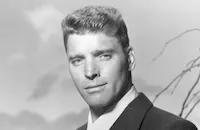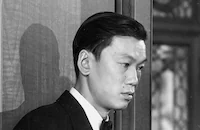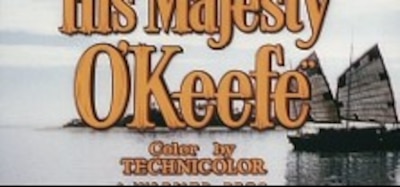His Majesty O'Keefe

Brief Synopsis
Cast & Crew
Byron Haskin
Burt Lancaster
Joan Rice
Andre Morell
Abraham Sofaer
Archie Savage
Film Details
Technical Specs

Synopsis
In 1870, a mutinous crew on the South Seas sets adrift Irish-American Capt. David Dean O'Keefe . Barely alive when his dory washes ashore on the island of Yap, O'Keefe is revived by German trader Alfred Tetens and medicine man Fatumak. Seeing abundant coconut trees growing on the island, O'Keefe dreams of making a fortune by harvesting coconut meat, called "copra," from which a highly sought oil is extracted. Tetens, who has lived on Yap for several years, tells O'Keefe that the natives cannot be induced to harvest the fruit, as they are uninterested in trade. O'Keefe remains confident that he will convince the islanders to help him, and learns that they greatly value "fei," a sacred stone they risk their lives to quarry on a distant island. Every year, the head chief, Boogulroo, challenges Tetens to a ritual combat. Although the German always declines by publicly acknowledging the chief's authority, O'Keefe accepts the challenge. Impressed by his prowess as a warrior, Boogulroo grants O'Keefe one "favor" and O'Keefe asks that coconuts be delivered to him. When a steamer arrives, bearing officials from the German company employing Tetens, O'Keefe sells his coconut meat and arranges for passage to Hong Kong. Before he leaves, O'Keefe bids a special goodbye to the native woman Kakofel, and Fatumak gives him a whale's tooth for remembrance, predicting they will meet again. In Hong Kong, O'Keefe looks for investors to buy him a ship, confident that he can make them rich from copra, but the big Spanish and German companies do not want him cutting into their trade. After O'Keefe refuses a partnership with slave trader Bully Hayes, Sien Tang, a wealthy dentist, offers O'Keefe a junk to sail. With a new crew and Sien Tang's nephew Chou as first mate, O'Keefe sails toward Yap. When bad weather slows them down, O'Keefe and his men are forced to stop at an island for provisions, but hostile natives attack, injuring O'Keefe. At the next island, Palau, the sailors spend several days with the hospitable natives and Australian trader Bart Harris. When Harris mistakes O'Keefe's courtship of his half-caste daughter Dalabo for seduction and threatens to shoot him, O'Keefe, who is in love, asks to marry her. Although the inexperienced Dalabo is unsure of her love, she agrees to be married after O'Keefe explains that the best kind of love grows slowly. When Fatumak and other men from Yap show up in their small crafts, O'Keefe realizes that Palau is the island where fei is collected. Using explosives, he helps them quarry the stone more quickly, then carries the unusually large load back to Yap in his ship. However, O'Keefe refuses to unload the fei until his ship and several storehouses are filled with copra. After accusing O'Keefe of trickery, Boogulroo returns with his men to Palau to gather more fei, claiming that only what is gathered in the old way has value. Inifel, a lesser chief, has his men supply the copra, and O'Keefe is soon sailing back to Hong Kong. There, Sien Tang provides an elaborate Chinese wedding for O'Keefe and Dalabo, but the next day, when they embark for the islands, Dalabo realizes that O'Keefe's mind is filled with visions of fame, riches and power, leaving little room for her. Meanwhile, Hayes and his men attack Yap and capture the villagers. O'Keefe returns in time to free them, retake the village and capture Hayes, but convinces the islanders to let Hayes's crew leave to spread the story of his defeat, so that future bullies will be deterred. Acknowledging his wisdom and leadership, the villagers crown O'Keefe as king. During the ceremony, Boogulroo returns from Palau and attacks O'Keefe, but the people believe that the gods are with O'Keefe, and the chief and his men are banished. Dalabo, who is aware of O'Keefe's greed and his on-going dalliance with Kakofel, is unimpressed with his rise to power, and sarcastically calls him "his majesty O'Keefe." When the Germans return, they refuse to accept O'Keefe as head of the island. After luring him off the island, they circle back, and with Boogulroo's help, take over the village. Tetens is killed in the skirmish, and while O'Keefe fights to reclaim the village, a German officer dies. Realizing that the islanders divided cannot survive, O'Keefe, with Fatumak's help, tells Boogulroo and Inifel to choose a new king to reunite the people. Because the manner of gathering fei has also become a dividing issue, O'Keefe announces that Boogulroo was correct in saying that only fei gathered in the old way has value. Then, expecting to be hanged, O'Keefe gives himself up to the Germans. However, as they try to arrest him, Boogulroo, speaking for all the villagers, asks, "Where are you taking our king?" The Germans give up and O'Keefe, who has regained Dalabo's respect, remains on the island.

Director

Byron Haskin
Cast

Burt Lancaster
Joan Rice
Andre Morell

Abraham Sofaer
Archie Savage

Benson Fong
Tessa Prendergast
Lloyd Berell
Charles Horvath
Philip Ahn

Guy Doleman
Grant Taylor
Alexander Archdale
Harvey Adams
Warwick Ray
Paddy Mulelly
Jim Crawford
Mr. Mclardy
Niranjan Singh
Crew
Marjorie Best
Joan Bridge
Manuel Del Campo
Borden Chase
Norman Deming
Gus Drisse
Robert Farnon
Stuart Freeborn
Edward S. Haworth
Stanley Haynes
Harold Hecht
Otto Heller
Liz Hennings
James Hill
Harold King
Burt Lancaster
Louis Levy
Richard Mcwhorter
Daniel Nagrin
Arthur Ridout
W. Simpson Robinson
Jane Roth
Francis J. Scheid
Margaret Shipway
Dimitri Tiomkin
Dimitri Tiomkin
Ivan Volkman
Vivienne Walker
Paul Francis Webster
Sid Wiles

Photo Collections
Film Details
Technical Specs

Articles
His Majesty O'Keefe
The 1950 novel His Majesty O'Keefe by Lawrence Klingman and Gerald Green in fact depicts a historical figure, Captain David Dean O'Keefe (ca. 1824-1921). Born in Ireland, O'Keefe immigrated to the U.S. and settled in Savannah, Georgia. In the 1870s he traveled to the South Pacific, where he became shipwrecked on the island of Yap. (The film fancifully depicts his crew throwing him off his own ship during a mutiny.) Eventually O'Keefe established a lucrative trade in copra, or dried coconut flesh, on the same island. During that period Yap was occupied by both Germany and Spain; characters depicted in the novel (and film) such as Alfred Tetins, Bully Hayes, Fatumak and Boogulroo all existed in real life.
The monetary system of circular stones depicted in His Majesty O'Keefe is known as rai; one variety of these stones is fei, though the film's script uses fei as a generic term. These discs were mostly quarried on the distant island of Palau and brought back to Yap on large outrigger canoes; the tremendous effort and risk required only added to the discs' value. The largest discs weighed many tons and were not moved from their original spot even after ownership changed. When O'Keefe introduced new tools and quarry methods to the Yap islanders, the greater ease of producing the stones eventually resulted in their decline in value, a problem which the film portrays. Although rai are no longer manufactured and the Yap islanders mostly have switched over to a standard currency system, the tradition of symbolic trading still continues to a certain extent.
According to Lancaster biographer Ed Andreychuk, initially Fred Zinnemann was slated to direct the film adaptation of His Majesty O'Keefe, with Frank Nugent and Laurence Stallings assigned to the script. Byron Haskin, the film's eventual director, recalls that the production encountered troubles early on. Warner cancelled the project at the last minute, after the crew had already arrived at the Fiji Islands, but Hecht somehow managed to rescue the situation.
In order to take advantage of frozen film funds in Britain, Hecht brought in some British crew and cast members. Warner Brothers built a virtually self-contained studio on the main island of Viti Levu, Fiji, complete with a soundstage, sound recording studio (postsynchronization was done onsite), administrative offices, and a Technicolor lab. Since there were limited accommodations on the island, Warner took over the entire Beachcomber Hotel at Deuba and constructed additional rooms to house the cast and crew. They also rented the entire village of Goloa and constructed new buildings, which they turned over to the villagers once shooting was finished.
Shortly before shooting began, Hecht brought in Borden Chase and James Hill to rewrite it at the last minute. Chase - a talented screenwriter who had worked on the script for Hawks' Red River (1948) - expressed frustration at the lack of organization and constant distractions, including story conferences during which Lancaster would wildly act out the scenes. Eventually Hill and Chase separated themselves from the rest of the crew and sent the finished script pages each day by messenger, after which Hecht would rewrite them. Shooting was interrupted almost daily by rain showers, and the crew encountered all sorts of problems from finding their clothing covered in mildew to fending off dengue fever. According to biographer Kate Burton, Lancaster later remarked: "There were times when the only thing idyllic about it was the Nadi airport where fast and comfortable planes took off constantly in a northeasterly direction for Hollywood."
Ultimately the film's production costs totaled $1.55 million, well over the $1.1 million per film stipulated by the contract with Warner Brothers. (Similarly, The Crimson Pirate [1952] had cost $1.85 million). As a result Warner offered to renew the contract only for lower budget films, so Hecht and Lancaster decided to sign up with United Artists instead. Still, according to director Haskin, His Majesty O'Keefe turned out to be one of the most profitable films of his career, thanks to TV sales. Hecht-Hill-Lancaster Productions even proposed at one point to spin it off into a television series, together with some of their other properties.
Producer: Harold Hecht
Director: Byron Haskin
Screenplay: Borden Chase, James Hill; Lawrence Klingman, Gerald Green (novel)
Cinematography: Otto Heller
Art Direction: Edward S. Haworth, W. Simpson Robinson
Music: Dimitri Tiomkin
Film Editing: Manuel Del Campo
Cast: Burt Lancaster (Captain David Dion O'Keefe/Narrator), Joan Rice (Dalabo aki Dali), Andre Morell (Alfred Tetins), Abraham Sofaer (Fatumak, Medicine Man), Archie Savage (Boogulroo), Benson Fong (Mr. Chou), Tessa Prendergast (Kakofel), Lloyd Berrell (Inifel), Charles Horvath (Captain Bully Hayes), Philip Ahn (Sien Tang, Dentist).
C-91m.
by James Steffen
Sources Andreychuk, Ed. Burt Lancaster: a Filmography and Biography. Jefferson, North Carolina and London: McFarland, 2000.
Byron Haskin. Interviewed by Joe Adamason. Metuchen, NJ: Directors Guild of America and Scarecrow Press, 1984.
Klingman, Lawrence and Gerald Green. His Majesty O'Keefe. New York: Charles Scribner's Sons, 1950.
Buford, Kate. Burt Lancaster: An American Life. New York: Alfred A. Knopf, 2000.
Scott, John L. "Witness of cannibal feast helps in production of Fiji Island film." New York Times, November 23, 1952, p.D1.

His Majesty O'Keefe
Quotes
Trivia
Notes
The title card reads: "Warner Bros. Pictures presents Burt Lancaster as His Majesty O'Keefe, Colour by Technicolor." After the opening credits, which list a primarily British crew, the following written statements appear onscreen: "This entire picture was photographed in the South Pacific...where for years the basic economy and wealth revolved around the dried meat of the coconut known as 'copra.' And on the island of Yap, the natives worshiped an exotic sacred stone they called 'fei.' We wish to acknowledge our gratitude to the Secretary for Fijian Affairs: to Ratu Penaia Lala Latianara Serua District Chief in Charge, and the wonderful people of the Fiji Islands." Voice-over narration, by Burt Lancaster as "David O'Keefe" and Joan Rice as "Dalabo" is heard intermittently throughout the film.
His Majesty O'Keefe was based on the life of nineteenth-century Irish-American adventurer David Dean O'Keefe, whose story was pieced together by authors Lawrence Klingman and Gerald Green in their semi-biographical novel of the same title. According to the authors, several characters in the book, who were also depicted in the film, were actual people: Bully Hayes, Bart Harris, Alfred Tetens, Friedlander, Weber, Fatumak, Kakofel, Boogulroo and Inifel. According to legend and some historical documents, O'Keefe, believing he killed a man, fled his home in Savannah, Georgia to join a pearl-diving expedition in the South Seas. In 1871, a typhoon shipwrecked the expedition and O'Keefe was the sole survivor. As depicted in the film, O'Keefe was nursed to health by Fatumak, medicine man on the island of Yap, where two years earlier, the Germans had established a trading post managed by Alfred Tetens and where the Spaniards also claimed interests. On Yap, the form of currency used was a stone disk, called "fei" or "rai," which the natives quarried from the island of Palau and hauled 280 miles to Yap in canoes. The value of each stone, which measured between approximately one and twelve feet wide, was determined by many factors, including the difficulty surmounted in obtaining it.
A German trading ship took O'Keefe to Hong Kong, but he returned the following year, commanding a Chinese junk named for his American wife, Catherine. In exchange for copra and betel nut, O'Keefe began using his junk to haul fei to Yap for the islanders. Although the fei transported by O'Keefe was valued lower than that brought over by canoe, the increase of fei on the island allowed less wealthy people to own money. So popular was O'Keefe with the natives of both Yap and Palau, that they refused to do business with anyone else, and for approximately thirty years, he held a monopoly on the copra trade. Nicknamed "His Majesty O'Keefe" because of his regal lifestyle, he amassed a great fortune, and Robert Louis Stevenson wrote about him. O'Keefe's Kanteen, filled with memorabilia, still stands on the site of the trading post and bar that O'Keefe established in 1874. Although U.S. currency has become the standard on Yap, fei is still sometimes used to pay dowries or purchase land.
An April 1951 Los Angeles Times news item announced that Fred Zinnemann would probably direct the film and a February 1952 Los Angeles Times news item reported that Frank Nugent was set to write the screenplay. However, Nugent's contribution to the film, if any, has not been determined. An August 1952 Daily Variety news item described how an elaborate facility, possibly the largest outside of Hollywood at that time, was constructed by Warner Bros. on the Fijian Island of Viti Levu, where the film was shot. In addition, portions of the film were shot in the village of Goloa, where additional huts were erected by the studio. A November 1952 Los Angeles Times article stated that Ratu Lala, the lineal descendant of Fijian kings, who is mentioned in the opening onscreen acknowledgments, assisted the production as liaison to the native Melanesians who served as extras and crew members.
According to an October 1952 New York Times article, before choreographing the dance sequences for the film, Daniel Nagrin lived in a Fijian village for a week while studying under Mokani, an old man who taught ceremonial dances to the children. September and October 1952 Hollywood Reporter news items add the following actors to the cast: Harry Hambleton, Eric Sterling and Jack O'Malley, but their appearance in the film has not been confirmed. According to a September 1953 Hollywood Reporter news item, Clark Dennis recorded music from the film on the Tiffany Records label. As reported in a June 1953 Hollywood Reporter news item, after producing His Majesty O'Keefe, Hecht and Lancaster severed Norma Productions' ties to Warner Bros., citing disagreements over budget and production concerns. In 1954, Hecht and Lancaster formed Hecht-Lancaster Company, which released films through United Artists.

Miscellaneous Notes
Released in United States on Video August 12, 1992
Released in United States Winter December 1953
Burt Lancaster reputedly directed the final location scenes, for which he received no credit, after director Byron Haskin had left for another assignment.
Released in United States on Video August 12, 1992
Released in United States Winter December 1953














